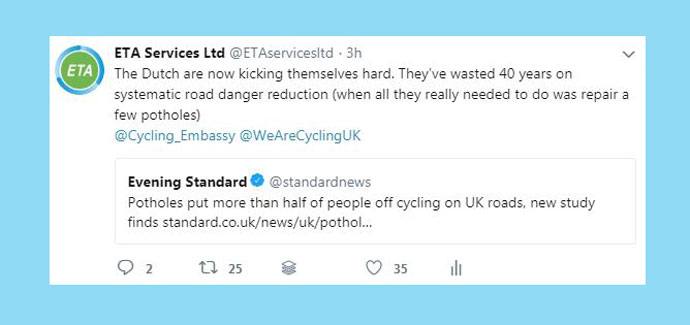
Odense is the third-largest city in Denmark and yet 81% of children ride to school, generally without their parents. Here in Britain, we appear happy with less than 2%.
Children should have the right to travel to school on foot or by bike without facing road danger – of every kind. Sixty nine children were killed and over 6,000 were injured on British roads in 2016, but the danger extends beyond the risk of being run over. Almost one thousand schools in Britain are near roads with harmful levels of illegal pollution.
It’s dire situation that only has a detrimental and immediate effect on our children’s health, but restricts their independence and personal development.
The increasing number of vehicles on British roads and its effect on the travel habits of children continues a vicious cycle – the more traffic there is, the more likely children are to be ferried to school by car. The proportion of 7-10 year olds making their way to school independently hovers at around 15 per cent.
The fact that fewer and fewer children are allowed to cross the road or travel to school unaccompanied is a disturbing trend – everything else being equal, children who get some exercise on their way to school are healthier and perform better academically than those driven to school.
It doesn’t help that in Britain we avoid addressing the root causes of why folk drive rather than walk or cycle. If you believe the results of a recent poll, the reason so few Brits cycle is potholes.

Don’t get us wrong, everyone deserves well-maintained roads, but the Dutch must be kicking themselves. They have spent the last 40 years developing a systematic approach to road danger reduction that’s the envy of the world – perhaps they were wasting their time when all they needed to enable almost a quarter of their population to cycle every day was fill a few potholes.
We need every British city to be like Odense. Transport planners; Don’t be like Britain. Be like Denmark.
An insurance company like no other
Not only are we Britain’s most ethical insurance company, we campaign for sustainable transport. Sometimes that means protesting until a school gets the zebra crossing they’ve been refused or running 60 roadshows this year to encourage people out of their cars, or fixing bicycles for free. We also launched Green Transport Week and helped establish Car Free Day and Twenty’s Plenty to name just a few. We’ve been campaigning for sustainable transport in this way for over 27 years with the help of people like you. Supporting this work is easy – you simply have to take out insurance with us. Home insurance, cycle insurance, travel insurance and breakdown cover and we take care of the rest. We provide an excellent level of cover while putting concern for the environment at the heart of all we do.

Chris
Great news from the Danes that’s just reminded me I’ll be heading off to Denmark this Summer and we’ve just booked our hire bikes. Thanks for the positive story!
Tony Williams
Perhaps I can explain that not all those who drive children to school are uncaring monsters determined to ruin children’s health and academic attainments.
We live in a village between Basingstoke and Andover. There’s an east – west bus service, but not north – south. The school is on the north side, up a steep hill.
Until recently my daughter walked her two daughters, aged 9 and 7, to school on two mornings a week – the days when she wasn’t working – and fetched them home on foot in the afternoons. On the other three mornings she dropped them off for a breakfast club on her way to work about 13 miles away. She travels there by car as there is no direct bus service. In the afternoons either my wife or I collect them. We live on the south side of the village, up another hill, and it’s about 0.89 of a mile each way. I’ve just measured it on Google Maps. I’m 78 and my wife is 77. I can do it, but she would find the hills difficult.
My daughter has just started almost full-time work, and they’ve moved to another village about four miles away. She drops them off every morning and continues to her work, but on Monday and Friday afternoons she leaves earlier so as to pick them up. They then return by car to their new home.
There are probably hundreds of thousands of families who use the car for reasons like those I’ve described. It isn’t laziness, or a thoughtless disregard for their children’s interests or the level of vehicle emissions.
Will anyone dare suggest that my granddaughters should be transferred to the school in the village they’ve moved to? The transfer might or might not benefit their education. The other school is full in some year-groups, with children coming by bus to the school in our village. If they could transfer, who would pick them up after school? Should I travel to the school in the other village – by bus, presumably – walk them back to their new home, wait till one of their parents arrives – then then get the bus back to where I live?
It’s just so easy to pontificate about how other people should conduct their lives, with no regard to the circumstances which lead them to make their decisions, and to imply that taking children to school by car is anti-social and almost a case of child abuse.
The ETA
We’re not certain anybody is suggesting that ‘taking children to school by car is anti-social and almost a case of child abuse’ – however, the road danger that prevents children from walking and cycling to school and which causes life-threatening levels of air pollution near schools, most definitely is.
Chris
4 miles is an easy distance by bike – but I suspect the answer would be “I can’t let them cycle 4 miles on our roads because the motor traffic is too dangerous”. What causes the motor traffic?
Anthony
I suspect many pot holes are a consequence of power steering. When I was learning to drive, pre-power steering, I was taught to turn the wheel whilst moving. Nowadays it’s easy to turn the wheel whilst stationary, and they do. Only outside the car can you hear the grinding of rubber on tarmac, to the detriment of both as well as fuel use.
Needless to say, with all the school gate comings and goings, there’s a lot of such abrasion there.
Vincent Edwards
The school run is a firmly-established institution which will not go away barring a 1970s-style oil crisis.
What concerns me is the behaviour of drivers on the school run. 20 mph speed limits mean nothing to school run mums and dads, desperate to unload their charges and get to work. Parking restrictions – be they yellow lines or zig zags do not apply to them. Pavements are for parking on. Neither the local authority nor Police enforce any restrictions, afraid they will be accused of only doing it to make money.
When plans for a third primary school in the same street near my home were announced, the headteacher-designate scoffed at concerns expressed by local residents about likely traffic chaos. Parents, it was said, would park in the nearby side streets and stride with their children to the school – Park and Stride! Guess who has proved to be right. Since then the headteacher has had to write to parents asking them to desist from tailgating teachers through the barrier into the staff car park. Nothing short of drive-through classrooms is good enough for some. As a result, parents of children who live locally fear it is too dangerous for children to walk to school unaccompanied.
There is plenty of free, easily-accessible parking within a two-minute walk, and some use it. But all too many people don’t walk if they can drive. And with zero-enforcement policies in respect of parking restrictions – lots of yellow paint but no traffic wardens – why should they care, so long as their children are safe?